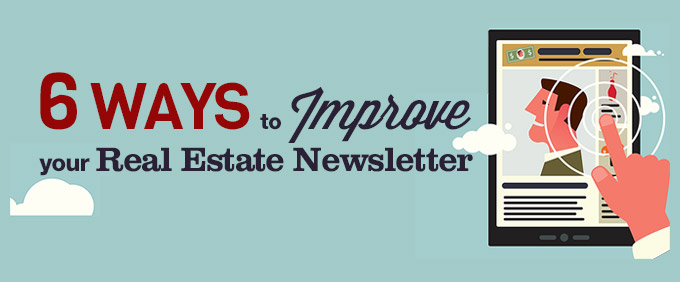6 Ways to Improve Your Real Estate Newsletter
Are you spending all your energy on social media marketing and less on sending out newsletter-type emails? If you’ve already built a solid email marketing list then maybe it’s time to revive your newsletter strategy.
A strategically worded and well timed e-mail blast that informs and intrigues can generate an even greater response than tweets and posts.
With the goal of improving email open rates and conversion, we’ve curated our top tips for a successful real estate newsletter (many of which we employ right here at Agent Image for our own email marketing campaigns).
#1: Use a personalized email address to send out your newsletter
Most of the time, the people in your email marketing list are not even people you have met face-to-face. Get a better response to your real estate newsletter by personalizing your emails.
- Make sure that the email address you are using to send the newsletter offers a personalized contact name as opposed to using something like [email protected] or [email protected]
- If you want to use a different email address for email marketing, that’s perfectly fine as long as recipients see a First name and Last name on the “From” field. For example, using a “no-reply” address is very impersonal and gets a much lower response.
- Personalize your email signature as well. Keep links to a minimum (just limit to the url of your website) to avoid your email being tagged as spam from link overuse.
#2: Personalize your Subject Line
The first thing that a recipient sees when they receive your e-mail is the subject line. Personalize it to catch their attention. Compare these two subject lines:
“Real estate in Orlando sees higher sales”
Versus
“Tom, real estate in Orlando is priced to move this quarter”
- Personalizing the subject line gets noticed more than others, and produces a 20% higher CTR (click-through rate).
- According to one study from the research company, Marketing Sherpa, this type of personalization causes 5% more people to open the e-mail and read it.
- A 2013 Email Market Study from Experian found that by adding the recipient’s name in the body of the e-mail generated 6 times the response.
#3: Create content that invites action
Anticipate the reaction of your recipients. If they opened your newsletter, what will they get?
- If it is purely a sales pitch about promos, listings, etc, it will have a high chance of going straight to the deleted folder.
- The goal of sending out a real estate newsletter should not be to promote listings. What you want is to get them to act - to read, reply and share/forward this newsletter to their circle or friends.
- Your newsletter should contain blog articles, market stats, tips and advice that is interesting and informative -- something that will reinforce brand recall to your readers and will make them remember that your are the local real estate expert in your area.
- So that when the time comes that they are in need of your services in buying or selling a house, you will be the one that they will contact.
Okay so what do you write about? You want to give theme valuable information, something they don’t know that is current and relevant that will stick in their heads. You want to be their resource for local real estate. Consider content like:
- Launch or opening of a new residential or commercial development. If it’s a residential building like a luxury condo, provide initial info on pricing, amenities, etc. If it’s a public development like parks, provide direction maps and more info, if it’s a commercial complex, put together a “things to see” guide.
- Local guides - favorite attractions, dining, shopping, outdoor activities
- Attractive infographic that concerns your area of expertise - job growth, new home sales, sold home prices,
- Interesting blog posts that talks about the lighter side of real estate
- Useful tips for selling a home, buying for investment, etc.
These are the types of subjects that your recipient will think about when he or she is having a conversation with a coworker or neighbor. Imagine the conversation going something like, “Yeah, I read that the elementary school is expanding. Yeah, they’re adding a new sports complex too.” When asked where they read it - you are the source!
#4: Use a conversational tone
The last thing that someone wants when they are reading their personal e-mail is a boring, dry, seminar on real estate.
- The tone of your real estate newsletter should be informal. The goal is to inform, intrigue, and entertain.
- From the subject line to the close, you should craft your newsletter as if you are talking to each person individually.
#5: Use strong CTA (Call to Action)
After reading your newsletter what do you want your recipients to do? That is the question you should ask yourself in order to close with a strong CTA buttons or graphic links that leads them to your website or social media pages. Some examples we like:
- Find out what your home is worth (free, no obligation)
- Confused about your home financing options? We have answers.
- Be awesome and share to your Twitter friends!
- View our curated “Dream Homes” list
#6: Strategic Frequency
The time of day and day of the week that you send e-mails (and how often you send them) has an impact on whether or not they will be read or deleted. We’ve compiled a few statistics from around the web on this topic. Here is what we found:
- People looking for entertainment respond more actively to e-mails sent on weekends (17%).
- On weekdays the best time to send an e-mail is between 8am and 10am or 3pm and 4pm.
- Most e-mails are read in the afternoons even though they are opened in the mornings.
- Now these stats may or may not apply to your niche. That’s why it’s important to experiment and note down your observations based on your email open stats.
- For example, if your newsletter contains light hearted articles, try sending it on a Saturday or Sunday morning. If you are alerting your contacts about an open house send it during afternoons so that it doesn’t get buried in the morning e-mails.
- Very important: do not bombard your contacts with constant emails! Pick one or two days out of the week and stick with them.
Striking the Right Balance
Consider that businesses in every industry are tweeting or posting something. Our Facebook newsfeed is getting more crowded by the day. Sending e-mail newsletters or even traditional print newsletters to your mailing list is one way to cut through the noise and reach your readers.




